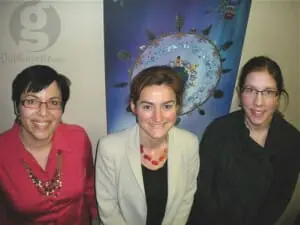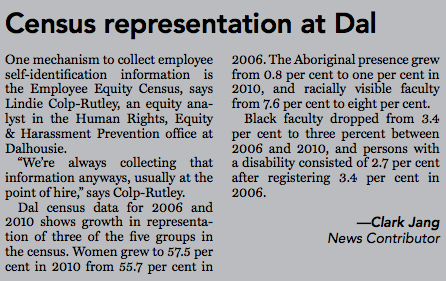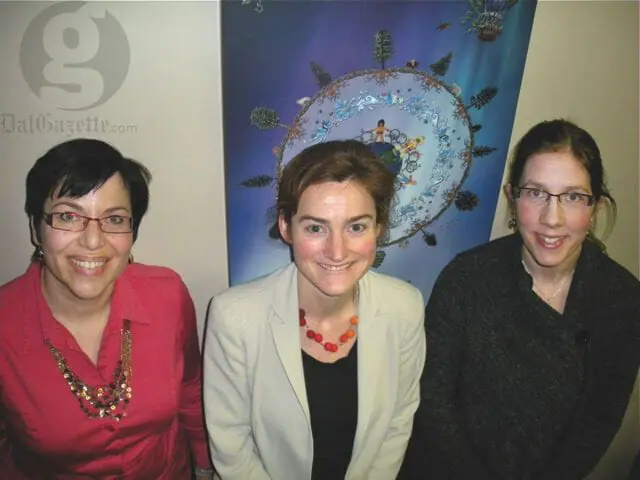
Not many people are familiar with Dalhousie’s policy on affirmative action and employment equity, or with the concept behind it. Perhaps they should be.
Nancy MacDonald is an assistant professor in the school of social work, and a PhD candidate. In 2001, she worked on a study about affirmative action, which involves giving members of under-represented groups preference in the hiring process. The study showed that affirmative action increased the number of social workers from designated groups, but did not actually prevent racial discrimination in the workplace or when accessing employment.
“It may get you in the door, but it doesn’t keep you in the door, and it fails because it does not recognize the systemic barriers that we experience,” says MacDonald.
The Office of Human Rights, Equity & Harassment Prevention (HREHP) at Dal was designed to make sure the university’s human rights, equity and harassment prevention policies are practiced.
Those who are interested in venturing onto the HREHP website to brush up on Dal’s guidelines are left to navigate through a maze of confusing language, links to affiliated websites and numerous policies, programs and guidelines.
But behind the mass of information lies a simple idea.
“The purpose of affirmative action and employment equity is to correct a historic disadvantage,” says Lisa DeLong, a human rights and equity advisor in the HREHP office. DeLong says once relative progress has been made in designated groups, ideally affirmative action cancels out its own need. Aboriginal persons, persons with a disability, visible minorities and women fall under the umbrella of designated groups.
“You’re aiming to correct the disadvantage, not to create a temporary correction,” says DeLong. “It’s the reality we live in that there’s a lot of historic disadvantage that prevents people from accessing higher education.”
One concern with policies like affirmative action and employment equity is that it promotes a form of reverse discrimination.
“It’s not discrimination to implement a program aimed at correcting a historic disadvantage,” says DeLong. “From my understanding that’s the reason for Section 15(2) in our Charter [of Rights and Freedoms].”
That section states that any law, program or activity aimed at correcting the conditions of historically disadvantaged groups is not discriminatory.
Another caveat of affirmative action is self-identification. During the application process, applicants are given the chance to identify as a member of an under-represented group. If they don’t, their applications are treated as a non-designated group member.
Sara Swasson, who identifies as Mi’kmaq, is studying for her master’s degree in health promotions. She believes racial targeting is one reason people may choose not to self-identify.
“There are stereotypes, like we are given leeway into programs, or that we don’t pay taxes,” says Swasson. “That’s not true.”
Marlo Shinyei, the academic recruitment advisor, says the perception of hiring solely because of an affirmative action program can be discouraging.
“There’s also the perception that affirmative action is lowering the bar,” adds DeLong. “That’s not the case. Everyone is enriched by having a more diverse crowd to work with.”

“I don’t think we’ve seen another specific initiative that has been so specifically focused on hiring or hiring goals,” says Shinyei.
When selecting candidates to meet hiring goals, Dal uses the test of “substantially better qualified.” The test states that unless a member of a non-designated group is substantially better qualified than the candidate from an under-represented group, the under-represented group member will have preference for the job.
“But it is context-specific. It’s different for every faculty,” says DeLong.
However, MacDonald thinks the policies and programs could be more inclusive.
“I do think there is room to expand the policies for other groups who experience other types of oppression,” says MacDonald.
Dal’s school of social work recognizes Aboriginals, persons with disabilities, visible minorities and women, as well as Acadian peoples and the lesbian, gay, transgender, two-spirited, queer and intersex (LGBTTQI) community in its affirmative action program. Acadian peoples and LGBTTQI individuals are not included in Dal’s definition of designated groups.
“That’s where the school [of social work] has been so progressive,” says MacDonald.
MacDonald points out that affirmative action and employment equity only apply to the hiring process. As one who has experienced racism, she feels the university should have more comprehensive strategies to promote inclusiveness and prevent discrimination within the workplace.
“We need to work with Dalhousie Faculty Association, the universities themselves and our departments in terms of what we can do in this university environment.”
“Oftentimes we’re left trying to keep ourselves balanced and healthy when we’re in an institution that doesn’t have the policies and practices in place, nor is prepared to consider racism because that’s such a taboo word.”
And even though the university has implemented policies like affirmative action and the Federal Contractors Program, MacDonald thinks there is still much to be done.
“Is it sufficient?” she asks. “No. We have a lot to do.”


Recent Comments